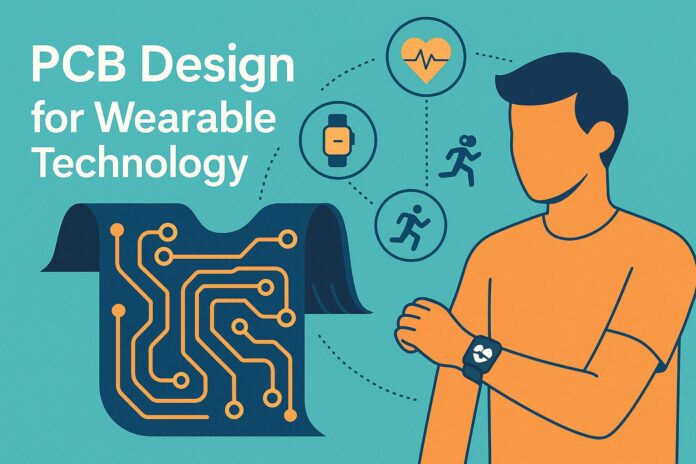Introduction to Wearable Technology
Wearable technology has rapidly evolved from simple step counters to sophisticated medical monitors, immersive AR/VR headsets, and ubiquitous smart‑watch ecosystems. Whether the goal is real‑time biometric sensing, untethered communication, or context‑aware feedback, every wearable device depends on a compact, robust, and energy‑efficient electronic core. That core is almost always a purpose‑built PCB design—often flexible, rigid‑flex, or ultra‑thin—that must coexist with fabrics, polymers, skin, sweat, and motion.
Unlike conventional boards hidden inside static housings, PCBs for wearables must bend, twist, dissipate heat through soft materials, survive daily washing, and remain comfortable to the human body. Meeting those requirements demands a new design mindset that blends electronics, materials science, mechanical engineering, and even fashion. This article explores the principles, materials, power schemes, manufacturing methods, and real‑world case studies that define successful PCB Design for Wearable Technology.
Flexibility and Miniaturization
Why Flexibility Matters
Human joints, muscles, and clothing rarely offer flat mounting planes. A traditional rigid FR‑4 board creates hard edges that abrade skin and concentrates stress along solder joints. Flexible circuits—built on polyimide, thermoplastic polyurethane (TPU), or stretchable elastomers—allow electronics to conform to wrists, ankles, and curved helmet interiors. Multilayer rigid‑flex constructions add localized stiffness for fine‑pitch ICs, while maintaining overall bendability where needed.
Strategies for Miniaturization
- HDI (High‑Density Interconnect): Blind and buried vias, stacked micro‑vias, laser‑drilled vias‑in‑pad, and 50 µm trace/space rules squeeze maximum routing under BGA or WLCSP packages.
- System‑in‑Package (SiP): Combining MCU, PMIC, RF front‑end, sensors, and memory in a single laminate or molded module cuts PCB estate while shortening RF paths.
- Component Embedding: Passive components or bare‑die chips embedded inside the substrate eliminate z‑axis height and free surface area.
- 3D Layout: Wearable device enclosures often have multiple curved surfaces—PCBs can be partitioned into interconnected flexible wings wrapping a battery or sculpted around bones.
Careful mechanical FEA modelling is essential: too‑tight bend radii (< R = 10× thickness for polyimide) can fracture copper traces; repeated flex cycles demand rolled‑annealed copper instead of electrodeposited copper to extend fatigue life.
Key Applications of Wearable Technology
| Segment | Typical Features | Special PCB Requirements |
| Consumer Fitness & Health | Heart‑rate, SpO₂, GNSS, BLE/ANT+, haptic feedback | Optical windows in PCB, low‑noise analog, shielded RF |
| Medical & Clinical | Continuous glucose monitors, smart plasters, ECG patches | ISO 13485 traceability, biocompatible coatings, sterilization resistance |
| Industrial & Enterprise | AR safety helmets, location beacons, exoskeleton controllers | Wide temp range (‑20 °C – 60 °C), IP67 sealing, rugged connectors |
| Military & First Responder | Physiological status monitoring, soldier hub, smart textiles | EMI hardening, encrypted comms, stealth‑friendly form factor |
| Sports & eTextiles | Smart jerseys, force‑sensing insoles, heated garments | Stretchable substrates, washable encapsulants, distributed power buses |
Each application pushes the PCB design envelope differently—whether ultra‑low current draw for week‑long wear, optical isolation for photoplethysmography, or mm‑wave antennas for 5G links.
Material Selection
Substrates
- Polyimide (PI): The workhorse for flex circuits—wide temperature tolerance (‑200 °C to 260 °C), good chemical resistance, and proven reliability.
- Thermoplastic Polyurethane (TPU): Softer and stretchable; ideal for eTextiles and epidermal patches where comfort is paramount.
- Liquid Crystal Polymer (LCP): Near‑hermetic, extremely low dielectric loss—excellent for sub‑6 GHz and mm‑wave antenna arrays in AR glasses.
- Silicone‑based Elastomers: Provide up to 20 % stretch; printing conductive inks directly creates seamless sensor arrays.
Conductors
- Rolled‑Annealed Copper: Grain orientation improves bend endurance (> 10⁶ cycles at 5 mm radius).
- Conductive Silver/Graphene Inks: Screen‑printed on TPU or fabrics for lightweight signal lines; ideal for disposable or low‑current biosensors.
- Gold or ENEPIG Finishes: Resist sweat corrosion and support fine‑pitch wire‑bonding or direct‑chip attachment.
Protective Layers
- Parylene C: Conformal vapor‑deposited coating only a few microns thick for moisture and salt protection without compromising flexibility.
- Medical‑grade Silicone Over‑mold: Adds cushioning, waterproofing, and skin‑safe contact.
Material choices heavily influence impedance, antenna efficiency, sensor accuracy, and battery life—iterative co‑design between electrical and mechanical teams is non‑negotiable.

Power Management
Energy is the scarcest resource in a wearable device—the PCB must orchestrate consumption down to the micro‑watt.
- Ultra‑Low Quiescent PMICs: Regulators with < 500 nA IQ extend standby times. Buck‑boost topologies maintain stable voltage as Li‑poly cells sag below 3 V.
- Dynamic Power Domains: Segment sensors, radios, and displays into individually switchable rails; use GPIO‑controlled load‑switches or eFuses.
- Energy Harvesting Integration: Flexible PV cells, thermoelectric generators, or piezo harvesters routed into the PCB can trickle‑charge buffers.
- Battery Management:
- NTC placement close to charge circuits to prevent thermal runaway in tight enclosures.
- Coulomb counting via dedicated fuel‑gauge ICs for accurate wear‑leveling statistics.
- NTC placement close to charge circuits to prevent thermal runaway in tight enclosures.
- RF‑Aware Layout: DC/DC inductors and fast edges radiate; keep them away from BLE antennas, add stitched ground fences, and synchronize switching to non‑critical RF windows if possible.
Challenges in Wearable Technology Development
- Thermal Hotspots: Skin contact limits surface temperature rise to ≈ 2 °C above ambient; spreading copper planes, graphite foils, or heat pipes dissipate SoC heat without burning users.
- EMC in Close Proximity: Multiple radios (BLE + NFC + GNSS) crowded in < 2 cm² demand careful filtering and coexistence timing.
- Biocompatibility & Allergies: Nickel‑based alloys can irritate skin; gold or medical‑grade stainless steel finishes prevent dermatitis.
- Ingress Protection vs. Breathability: Sweat‑proof casings often trap condensation; Gore‑Tex vents plus hydrophobic nano‑coatings keep electronics dry while allowing vapor to escape.
- Regulatory Hurdles: IEC 60601 (medical), FCC/CE (RF), REACH/RoHS (materials) all impose documentation and testing overhead.
Manufacturing Processes
- Additive Flex Manufacturing
- Laser‑direct structuring (LDS) deposits copper only where needed on 3D plastic frames—popular in earbuds and smart rings.
- Inkjet or aerosol jet printing for prototype runs with feature sizes < 50 µm.
- Laser‑direct structuring (LDS) deposits copper only where needed on 3D plastic frames—popular in earbuds and smart rings.
- Roll‑to‑Roll (R2R) Processing
- Enables continuous flex circuit production, lowering cost for smart patches and electronic textiles.
- Enables continuous flex circuit production, lowering cost for smart patches and electronic textiles.
- Hybrid Rigid‑Flex Assembly
- Sequential lamination: rigid FR‑4 islands bonded onto PI tails.
- Crease‑relief slots milled to guide folding during final assembly.
- Sequential lamination: rigid FR‑4 islands bonded onto PI tails.
- Component Attachment
- Anisotropic Conductive Film (ACF) bonding for chip‑on‑flex cameras or display connectors.
- Low‑temperature solder pastes (< 175 °C) protect heat‑sensitive substrates.
- Anisotropic Conductive Film (ACF) bonding for chip‑on‑flex cameras or display connectors.
- Testing & Inspection
- Flying‑probe testers adapt to flexible panel stretch.
- Dynamic bend‑cycle testers simulate years of flexing within days (e.g., 150 k cycles at 10 Hz, 15 mm radius).
- Flying‑probe testers adapt to flexible panel stretch.
- Final Encapsulation
- Over‑molding with liquid silicone rubber (LSR) in aluminum tools designed to avoid air entrapment around micro‑vias.
- Over‑molding with liquid silicone rubber (LSR) in aluminum tools designed to avoid air entrapment around micro‑vias.
Case Studies
Smart Fitness Band SoC Module
A Tier‑1 wearable brand reduced PCB area by 35 % using a six‑layer HDI rigid‑flex: two rigid islands host a 77‑ball BGA MCU and a 0201‑component dense PMIC, connected by a 50 µm‑thick PI flex tail looping around the battery. Rolled‑annealed copper maintained integrity after > 500k wrist flex cycles. Average current draw dropped to 75 µA, enabling seven‑day battery life.

Disposable Medical ECG Patch
A startup designed a single‑use 72‑hour ECG patch on TPU. Screen‑printed silver traces and carbon electrodes merged with a zinc‑air coin cell. A minimalist PCB region carried a Bluetooth Low Energy SoC and analog front‑end. Parylene C coating plus a medical silicone adhesive met ISO 10993 biocompatibility. Manufacturing used roll‑to‑roll printing and laser cutting, reaching <$1.40 unit cost in volume.
AR Smart Glasses
To fit within the temple arms, the design team embedded a flex‑rigid stack: LCP antenna layer, PI sensor layer, and FR‑4 logic layer laminated together. An SiP packaged the Snapdragon‑class SoC, LPDDR, PMIC, and dual‑band Wi‑Fi/BT transceiver. Heat was spread via graphite foil backed by a magnesium alloy frame, keeping temple temperature at 38 °C under peak load.
Future Trends in Wearable Technology
- Stretchable PCB Meshes: Serpentine copper traces embedded in silicone deliver ±25 % strain, enabling electronic tattoos and smart compression garments.
- Chiplets & Heterogeneous Integration: Partitioning radios, AI accelerators, and sensors into smaller dies linked by embedded interposers reduces both footprint and power.
- On‑body Energy Harvesting: Flexible perovskite solar cells, kinetic piezo films, and body‑heat thermoelectrics integrated directly onto the PCB layers.
- AI‑in‑Sensor: In‑memory compute and always‑on machine‑learning cores lower data transmission needs, saving battery.
- Recyclable & Biodegradable Boards: Water‑soluble substrates (e.g., polylactic acid blends) and conductive inks based on zinc or magnesium for eco‑friendly disposables.
Conclusion
PCB Design for Wearable Technology is a multidisciplinary frontier where electrical ingenuity intersects with human ergonomics, fashionable aesthetics, and rigorous safety. Success hinges on mastering flexible substrates, miniaturized interconnects, ultra‑low‑power architectures, and skin‑safe materials—while orchestrating scalable manufacturing flows from roll‑to‑roll printing to ultra‑dense SiP assembly. As wearables continue to disappear into clothing, implants, and even brain–computer interfaces, the printed circuit board will remain the silent workhorse—smaller, thinner, and more powerful with every iteration.
